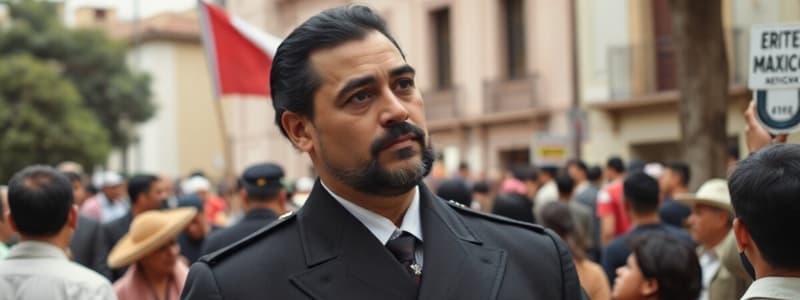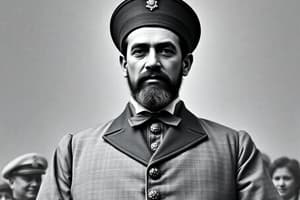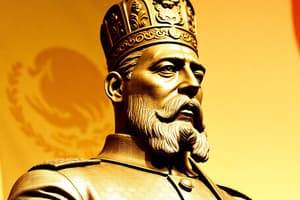Podcast
Questions and Answers
What was the approximate population of Mexico City in 1910?
What was the approximate population of Mexico City in 1910?
- 200,000
- 15,160,000
- 471,066 (correct)
- 88.5%
Which city experienced the most notable population growth during the Porfiriato, going from under 2,000 inhabitants in 1876 to over 43,000 in 1910?
Which city experienced the most notable population growth during the Porfiriato, going from under 2,000 inhabitants in 1876 to over 43,000 in 1910?
- Nuevo Laredo
- Mexico City
- Torreón (correct)
- Salina Cruz
What was the approximate average annual population growth in Mexico during the Porfiriato, from 1874 to 1910?
What was the approximate average annual population growth in Mexico during the Porfiriato, from 1874 to 1910?
- 43,000
- 267
- 180,000 (correct)
- 88.5%
What was a key factor contributing to the growth of cities like Torreón, Nuevo Laredo, and Salina Cruz during the Porfiriato?
What was a key factor contributing to the growth of cities like Torreón, Nuevo Laredo, and Salina Cruz during the Porfiriato?
Which of these factors is NOT mentioned as a contributing factor to Mexico's population growth during the Porfiriato?
Which of these factors is NOT mentioned as a contributing factor to Mexico's population growth during the Porfiriato?
What was the population increase in Cananea from 1876 to 1910?
What was the population increase in Cananea from 1876 to 1910?
Which city is referred to as the Emerald City in the context of urban improvements during the Porfiriato?
Which city is referred to as the Emerald City in the context of urban improvements during the Porfiriato?
What types of activities did officials and elites develop in the Oaxacan capital?
What types of activities did officials and elites develop in the Oaxacan capital?
What societal issue remained prevalent despite urban improvements during the Porfiriato?
What societal issue remained prevalent despite urban improvements during the Porfiriato?
What method was used to beautify and socially order cities during the Porfiriato?
What method was used to beautify and socially order cities during the Porfiriato?
What was the average lifespan of the Mexican population in the Porfiriato era?
What was the average lifespan of the Mexican population in the Porfiriato era?
What was a significant factor that contributed to the high mortality rate among children?
What was a significant factor that contributed to the high mortality rate among children?
How did the population of Mexico City change between 1874 and 1910?
How did the population of Mexico City change between 1874 and 1910?
What was the average annual population growth rate of Mexico during the Porfiriato?
What was the average annual population growth rate of Mexico during the Porfiriato?
What was the primary factor behind the significant population growth during the Porfiriato?
What was the primary factor behind the significant population growth during the Porfiriato?
Flashcards
Mexico's Population Growth under Porfirio Diaz
Mexico's Population Growth under Porfirio Diaz
The Porfiriato era saw Mexico's first period of sustained population increase, driven by stability, reduced social disruptions and modest improvements in public health and sanitation.
Population Growth During the Porfiriato
Population Growth During the Porfiriato
From a population of 8.7 million in 1874, Mexico's population surged to 15.2 million by 1910. This represents a significant increase, fueled by declining death rates and improved health conditions.
Increased Rate of Population Growth during the Porfiriato
Increased Rate of Population Growth during the Porfiriato
A significant demographic shift occurred in Mexico under Porfirio Diaz, with the average annual population growth rising from 43,000 to 180,000. This indicates a rapid expansion of the population during the Porfiriato.
Mexico City's Population Boom under Diaz
Mexico City's Population Boom under Diaz
Signup and view all the flashcards
Urbanization during the Porfiriato
Urbanization during the Porfiriato
Signup and view all the flashcards
What was the Porfiriato?
What was the Porfiriato?
Signup and view all the flashcards
How did Cananea's population change during the Porfiriato?
How did Cananea's population change during the Porfiriato?
Signup and view all the flashcards
What were the key urban improvements during the Porfiriato?
What were the key urban improvements during the Porfiriato?
Signup and view all the flashcards
How did Oaxaca display urban changes during the Porfiriato?
How did Oaxaca display urban changes during the Porfiriato?
Signup and view all the flashcards
What were some social challenges during the Porfiriato?
What were some social challenges during the Porfiriato?
Signup and view all the flashcards
Mexican Population Increase
Mexican Population Increase
Signup and view all the flashcards
Increased Rate of Population Growth in Mexico
Increased Rate of Population Growth in Mexico
Signup and view all the flashcards
Mexico City's Population Boom
Mexico City's Population Boom
Signup and view all the flashcards
Urbanization under Diaz
Urbanization under Diaz
Signup and view all the flashcards
Study Notes
Society and Culture During the Porfiriato
- Significant changes in Mexican society and culture mirrored political and economic shifts during this time period.
- A middle class emerged and began to view Mexico differently.
- Mexico's achievements in technology and culture were showcased at international exhibitions.
Population
- Mexico experienced sustained population growth due to stability and improved health and sanitation.
- The population grew from 8,744,000 in 1874 to 15,160,000 in 1910.
- The average annual population growth was approximately 180,000 during the Porfiriato.
- Mexico City experienced particularly rapid growth, increasing by 88.5% between 1874 and 1910.
- Smaller villages developed into towns and cities due to railroad construction, mining activities, and port improvements.
- Cities like Torreón, Sabinas, and Nuevo Laredo saw significant population increases.
Studying That Suits You
Use AI to generate personalized quizzes and flashcards to suit your learning preferences.
Related Documents
Description
Explore the pivotal changes in Mexican society and culture during the Porfiriato era, a period marked by significant political and economic developments. Discover how population growth and the emergence of a new middle class influenced Mexico's cultural landscape and technological advancements showcased internationally.




